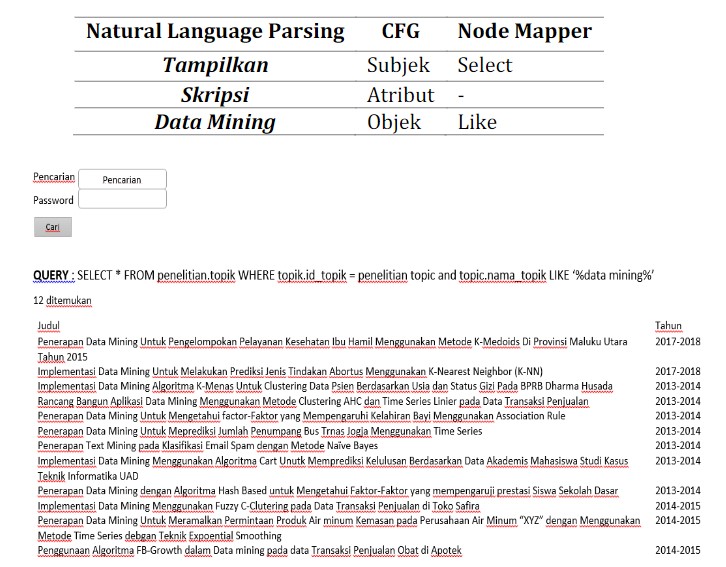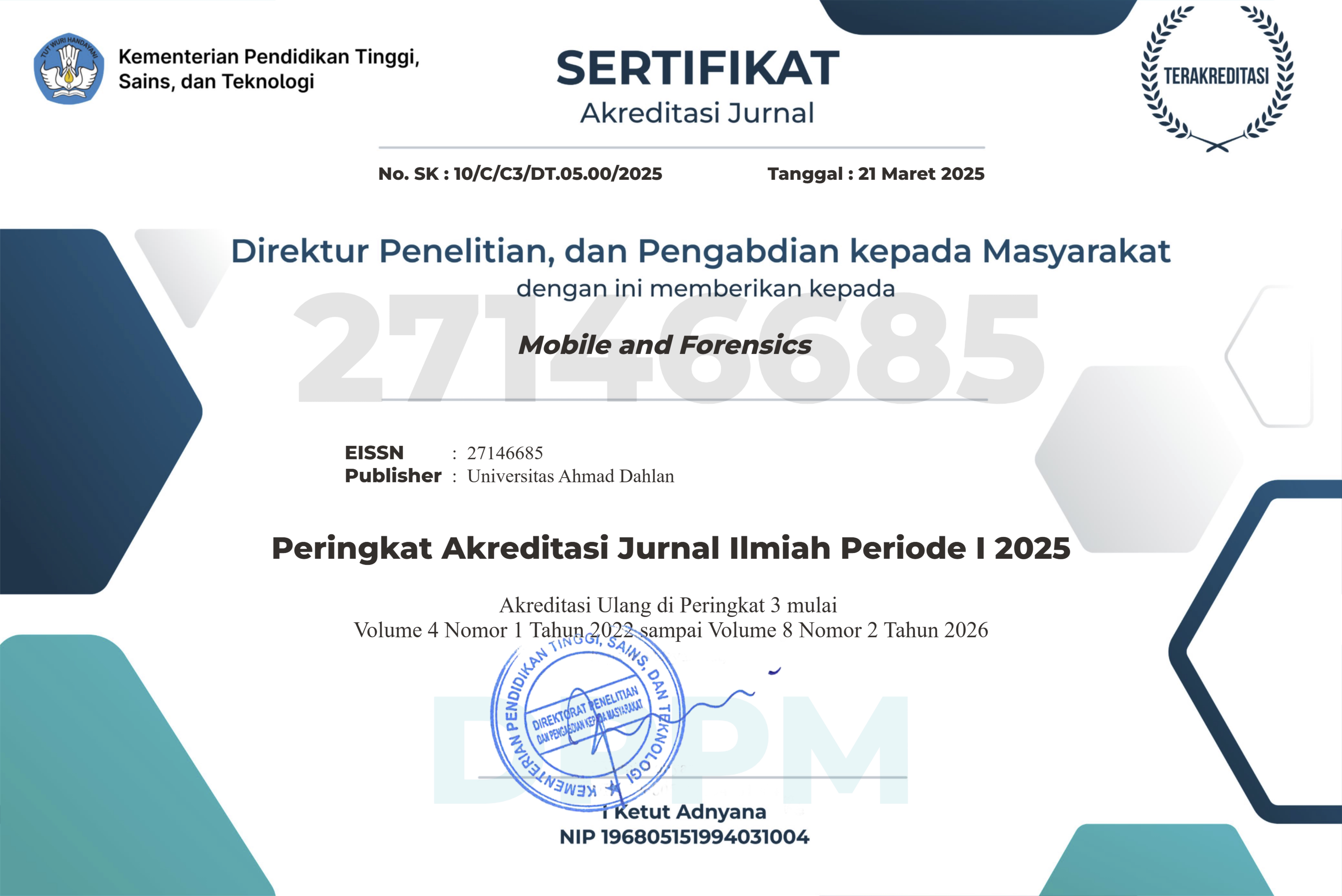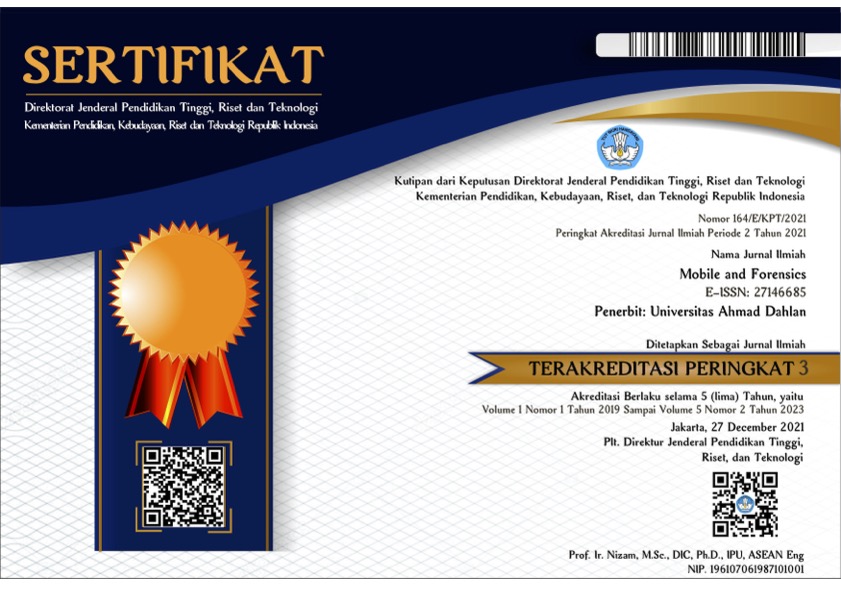Pemanfaatan Bahasa Alami Dalam Penelusuran Informasi Skripsi Melalui Digital Library
DOI:
https://doi.org/10.12928/mf.v2i1.2040Keywords:
digital library, natural language processing, query, skripsi, NLIDBAbstract
Daftar judul skripsi yang ada di web digilib.uad.ac.id belum digunakan secara optimal. Kesulitan menentukan topik serta pengelolaan data pada sistem yang belum memadai menjadi beberapa kendala mahasiswa. Penelitian ini bertujuan membangun pencarian informasi skripsi dengan antarmuka bahasa alami agar mudah dalam menulis kriteria pencarian tanpa harus terikat formulir pencarian. Penelitian ini menggunakan data skripsi untuk dikelola. Pengambilan data dilakukan menggunakan pendekatan Natural Language Processing. Masukan dalam bentuk kalimat bahasa alami digunakan untuk mencari data. Proses Parsing dilakukan untuk memecah kalimat input dan mendeteksi kata kunci yang relevan. Pengembangan aturan produksi dalam Context Free Grammar diperlukan untuk menerjemahkan bahasa alami ke dalam query. Kalimat yang melewati tahap parser diterjemahkan ke dalam bahasa SQL. Sistem ini berhasil menampilkan informasi skripsi berupa daftar judul berdasarkan topik, metode, dan objek penelitian sesuai kalimat pencarian dengan nilai precision sebesar 89,3% dan recall sebesar 100%. Keberadaan model pencarian informasi dengan antarmuka bahasa alami dapat menjadi alternatif dalam proses pencarian informasi skripsi guna menyediakan sistem yang lebih fleksibel.
The use of the existing digital library has not been used optimally. Difficulties in determining topics and managing data in an inadequate system are among the obstacles for students. This study aims to build a thesis information search with a natural language interface so that it is easy to write search criteria without having to be tied to a search form. This research uses thesis data to be managed. Data were collected using the Natural Language Processing approach. Input in the form of natural language sentences is used to find data. The parsing process is carried out to break down the input sentence and detect relevant keywords. Development of production rules in Context Free Grammar is necessary to translate natural language into queries. Sentences that go through the parser stage are translated into SQL language. This system succeeds in displaying thesis information in the form of a list of titles based on topics, methods, and research objects according to the search sentence with a precision value of 89% and a recall of 100%. The existence of an information retrieval model with a natural language interface can be an alternative in the thesis information search process in order to provide a more flexible system.
References
[2] P. Devale and A. Deshpande, "Probabilistic Context Free Grammar : An Approach to Generic Interactive Natural Language Interface to Database," Journal of Information, Knowledge and Research in Computer Engineering, vol. 01, no. 02, 2011.
[3] K. W. C. X. Yilin Gao, "Natural Language Interface for Relational Database," Final Report, 2 12 2016.
[4] N. Nihalani, S. Silakari and M. Motwani, "Natural Language Interface for Database : A Brief Review," International Journal of Computer Science Issues, vol. 8, March 2011.
[5] M. Tyagi, "Natural Language Interface to Database," International Journal of Science and Research, vol. 3, no. 5, May 2014.
[6] R. John and S. Govilkar, "Information Retrieval Technique for Web using NLP," International Journal of Natural Language Computing, vol. 6, no. 5, October 2017.
[7] Y. Gao, K. Wang and C. Xu, "Natural Language Interface for Relational Database," Final Report, 2 Dec 2016.
[8] S. Raharjo and S. Hartati, "Antar Muka Bahasa Alami untuk Melakukan Query terhadap Terjemahan Al Quran," Teknologi, vol. 7, no. 1, 2014.
[9] J. Patel and J. Dave, "A Survey : Natural Language Interface to Database," International Journal of Advanced Engineering and Research Development, 2015.

Downloads
Published
Issue
Section
License
Copyright (c) 2020 Dewi Soyusiawaty, Anna Hendri Soleliza Jones

This work is licensed under a Creative Commons Attribution-ShareAlike 4.0 International License.
Start from 2019 issues, authors who publish with JURNAL MOBILE AND FORENSICS agree to the following terms:
- Authors retain copyright and grant the journal right of first publication with the work simultaneously licensed under a Creative Commons Attribution License (CC BY-SA 4.0) that allows others to share the work with an acknowledgment of the work's authorship and initial publication in this journal.
- Authors are able to enter into separate, additional contractual arrangements for the non-exclusive distribution of the journal's published version of the work (e.g., post it to an institutional repository or publish it in a book), with an acknowledgment of its initial publication in this journal.
- Authors are permitted and encouraged to post their work online (e.g., in institutional repositories or on their website) prior to and during the submission process, as it can lead to productive exchanges, as well as earlier and greater citation of published work.

This work is licensed under a Creative Commons Attribution-ShareAlike 4.0 International License.












 Mobile and Forensics (MF)
Mobile and Forensics (MF)